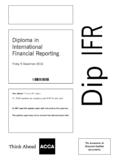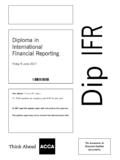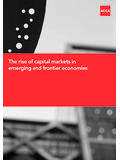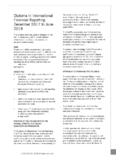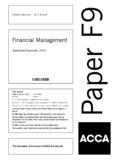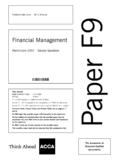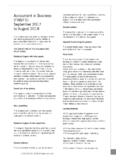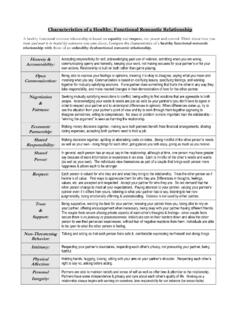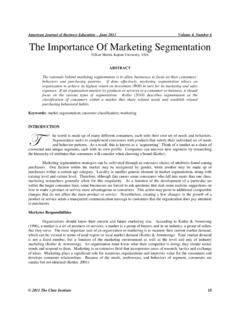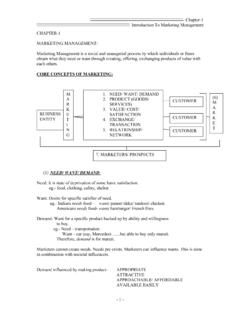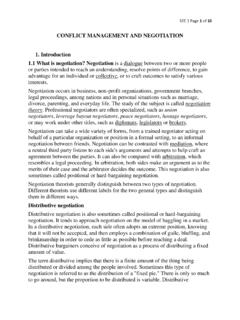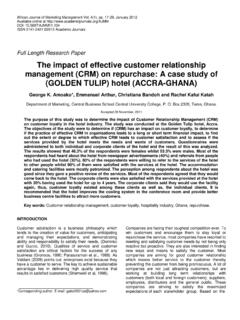Transcription of The role of marketing - ACCA Global
1 RELEVANT TO FOUNDATION LEVEL PAPER FAB / ACCA QUALIFICATION PAPER F1 2012 ACCA The role of marketing Section B2(e) of the Paper FAB Study Guide states that candidates should be able to describe the roles and functions of the main departments in a business organisation: research and development, purchasing, production, direct service provision, marketing , administration and finance. The next section of the Study Guide amplifies the requirements in relation to marketing , setting out the following learning outcomes. Explain the role of marketing in an organisation: i) the definition of marketing ii) the marketing mix iii) the relationship of the marketing plan to the strategic plan. This article provides an introduction to these important marketing concepts. WHAT IS marketing ? The definition of marketing published by the UK s Chartered Institute of marketing is the management process responsible for identifying, anticipating and satisfying customer needs profitably.
2 There is no doubt that marketing is a management process, as most successful organisations regard it as a crucial set of co-ordinated activities that must be driven from the strategic level of a business. Many organisations have an executive director with functional responsibility for marketing but, even if this is not the case, it is usually necessary for a strategic marketing plan to be put in place and implemented, consistent with the goals and objectives set out in the corporate plan. Despite a widely held perception that marketing is synonymous with selling, the definition confirms that the scope of marketing extends far beyond selling alone. Indeed, a business strategy built on selling and without due attention to other important marketing activities can have serious shortcomings: the customer s needs may be overlooked, the organisation may sell goods and services that the customer does not need, or the customer may have needs for the organisation s products and services but may purchase the wrong ones.
3 The essence of marketing is captured in the words identifying, anticipating and satisfying . These imply a process through which the organisation must find out what customers want , or carry out research into what customers are likely to want in the future, and then fulfil these needs by deploying its resources in an appropriate manner. The process has to be dynamic, as needs and preferences change over time, rendering some goods and services less 2 THE ROLE OF marketing NOVEMBER 2012 2012 ACCA suitable for their needs , or even obsolete. There are countless examples of products that have fulfilled genuine needs in the past, sometimes for long periods of time, but have eventually been superseded by alternative choices due to changes in needs , tastes and preferences, or have become totally unnecessary for consumers. Examples include audio cassettes, Super 8 cine films and projectors, twin tub washing machines and cash registers.
4 Successful business organisations therefore regard marketing as a continuous process, through which actual and perceived customer needs are constantly analysed and monitored in order to fulfil these needs to the extent that the organisation s resources and capabilities allow. THE marketing MIX The marketing mix is a model used when considering the range of activities necessary to construct and implement a comprehensive marketing strategy. It is most commonly expressed in terms of the four Ps of product, price, promotion and place. Place in this context refers to all activities associated with distribution. Product This element of the marketing mix considers the technical features, benefits and limitations of the product or products offered by the business. Depending on the nature of the business, products can be physical goods or services. The technical features of the product are important because they will determine whether it will meet the actual or anticipated needs of the customer.
5 Features are expressed as technical specifications and capabilities, and sometimes the limits to which the product is subject. Benefits are the utility to the customer and confirm what may be expected of the product. Benefits have an important role to play when devising promotional activities, and are therefore the crucial link between the product and promotion elements of the mix. Some products are subject to a derived demand, so the features may be quite distinct from the benefits of the end product. For example, nobody actually wants a mortgage, as this represents a large, long-term financial commitment. The benefit lies in owning an apartment or house, and without the mortgage, of course, few people can realise this aspiration in the short term. Product planning considers the position of the product within the portfolio of products offered by the organisation, and the potential contribution the product has to make to its future success.
6 Nearly all products may be considered with reference to the product life cycle. This model suggests that products pass sequentially through various stages over time, with revenues 3 THE ROLE OF marketing NOVEMBER 2012 2012 ACCA increasing through the introduction and growth stages, then tailing off and eventually declining as shakeout, maturity and decline take place. The product of professional firms is the services they offer, which are mainly intangible but may sometimes be delivered as reports and other outputs. Price This refers not only to the price of the product, but to all costs related to the purchase. It may be expressed in monetary terms, a rate of interest, costs, fees, or a combination of all these elements. The price may be a one-off payment, or a series of payments over time. It may be subject to time limits (such as a special deal for a limited period).
7 It may also be conditional on purchasing other products, or a minimum lock in period, such as a mobile telephone contract with a minimum duration. In the context of professional services, price is expressed as fees or charges. Promotion Promotion refers to all activities that are intended to inform the customer and influence the purchasing decision. The range of promotional media deployed by an organisation is sometimes referred to as the promotional mix. This includes: advertising direct selling, such as face-to-face interactions and telephone or online sales public relations merchandising sponsorship. Promotion may be highly specific to individual products or a range of products, or may enhance brand recognition in respect of the organisation s public image. In some cases, the name of the product may become synonymous with the organisation itself.
8 For example, the ballpoint pen was once referred to routinely as a biro , which is both the inventor s surname (Laszlo Biro) and the name of his company. Likewise, a vacuum cleaner is still called a hoover by many consumers, Hoover being the name of just one producer. The promotional mix varies widely from organisation to organisation. Fast moving consumer goods producers rely extensively on advertising, while life assurance companies have traditionally used direct selling to a much greater extent. Market segmentation can be used for both research and planning purposes. It is highly relevant when considering the promotional mix, and is also important when considering the other elements of the marketing mix. Market 4 THE ROLE OF marketing NOVEMBER 2012 2012 ACCA segmentation involves analysis of the market with reference to homogeneous sub-sets that share like characteristics.
9 Commonly used segments include: age gender geographical location socio-economic groups psychological factors, such as risk appetite, desire to conform or be different, and so on. Segmentation provides insights into strategic opportunities and options. For example, some companies choose a highly focused approach by targeted marketing aimed at very specific market segments (Club 18-30 holidays, insurance for drivers with clean licences), while others apply differentiated marketing strategies to address several segments deploying different marketing mixes (fast moving consumer goods companies often produce low price brands and premium priced brands within their product portfolios). As legal constraints and universally accepted professional standards have changed over time, the promotional mix used by professional firms has changed radically in recent years.
10 In many countries, accountants, lawyers and doctors were forbidden from advertising at all, and had to rely on testimonials and personal referrals, and even when such rules were relaxed, many professionals frowned upon promotion in the conventional sense. Such attitudes are rarely encountered today. Place This refers to all activities related to moving the product from the producer to the consumer. It is concerned with distribution through the producer s channels to market. Distribution may involve physically moving the product to the consumer, or to intermediaries who take responsibility for different stages of distribution, such as agents and wholesalers. In retail industries, distribution was once only concerned with transferring goods from the point of production to the point of sale, but the logistics have now changed as more companies embrace online orders and home delivery alongside (and, in some cases, instead of) their stores.

